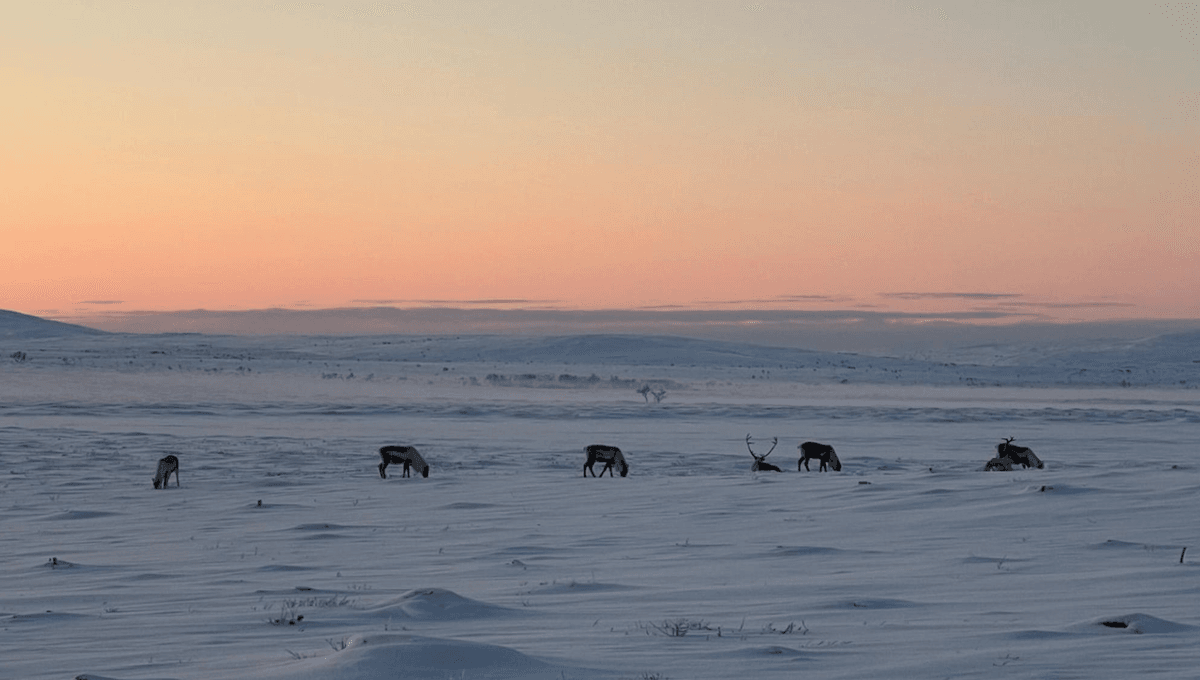
Deep snows prevent the release of carbon dioxide from boreal forests, but when the snows are shallower it can escape, making global heating almost impossible to stop. However, reindeer and their wild counterparts caribou greatly reduce this problem, provided they are allowed to graze freely, new research indicates.
The most frightening scenarios for the global climate involve an initial warming from burning fossil fuels changing ecosystems to release carbon trapped in plants or soils. This would cause more warming, even if humanity’s emissions were to turn off, creating a runaway effect we’d have almost no chance to stop.
The Arctic tundra and northern forests are not the only locations where this could occur, but since they capture half of the carbon dioxide absorbed on land, they’re key to climate stability. With a reservoir estimated at a trillion tons of carbon in forested lands alone, changes in the north may also be the biggest threat, particularly as snow seasons become more erratic.
To understand how this carbon bomb is affected both by shifting climates and animals, researchers studied the release of carbon from 42 plots in Finland’s pine forests between 2019 and 2023. At Oulanka, reindeer have been excluded for 25 years from part of a forestry site, but are free to graze the other part. At Kevo, an area ungrazed for 55 years was compared with neighboring grazed forest. Each year snow was added to some plots, and removed from others, to observe the effects.
Results from the Kevo restricted forest confirmed climate scientists’ fears. In years when the snow was deep, little carbon was released, but more paltry snowfalls led to dangerous amounts of carbon escaping to the atmosphere. In line with past evidence, the release is greater not just when the snow is on the ground, but in the summer following a shallow snowfall, probably because the soil is drier.
However, at both sites little carbon escaped grazed areas even in low-snow years. Net release was three times as high from ungrazed plots when snow cover was kept low, compared to grazed plots. Remarkably, at Oulanka, ungrazed plots released little carbon even with little snow. It seems the benefits of grazing last long after the grazers are gone – but not for half a century.
“Altogether, this could indicate that northern coniferous forests may be relatively well resistant to short-term changes in winter climate,” University of Oulu PhD student Noora Kantola said in a statement.
Replication will be required to prove the difference between the sites is indeed the reindeer, rather than some other factor the researchers have missed. Nevertheless, the authors think the most likely explanation lies with lichen, which the reindeer graze, and which grows back only very slowly in the cold climate.
“It is possible that at Kevo, the substantially recovered lichen cover has influenced soil temperature and moisture conditions. Together with changing snow depth, these factors may affect soil decomposers and thereby the amount of carbon released,” Kantola said.
Either way, it seems that where grazing has occurred in recent decades, forests can survive years with little snow without releasing much of their carbon onto an overburdened atmosphere. However, where reindeer are a distant memory, and lichen is now abundant as a result, a low snow year represents a carbon bomb.
Other programs from the same university are exploring how grazing affects tree growth and other aspects of forest ecology. Already, one study found that reindeer also counter the way hotter summers increase carbon release from tundra.
Reindeer and caribou numbers are declining, so their restoration could become a climate priority.
If only flying reindeer existed outside stories – presumably they’d have cleared the fences that exclude them at Kevo and similar areas and stopped carbon escaping the soil. Then again, if reindeer flew, we’d also have an alternative to one of humanity’s major carbon emitting industries.
The study is published open access in Science of the Total Environment.
Source Link: Reindeer Bring A Gift Greater Than Any Of Santa’s – Hope Of A Stable Climate